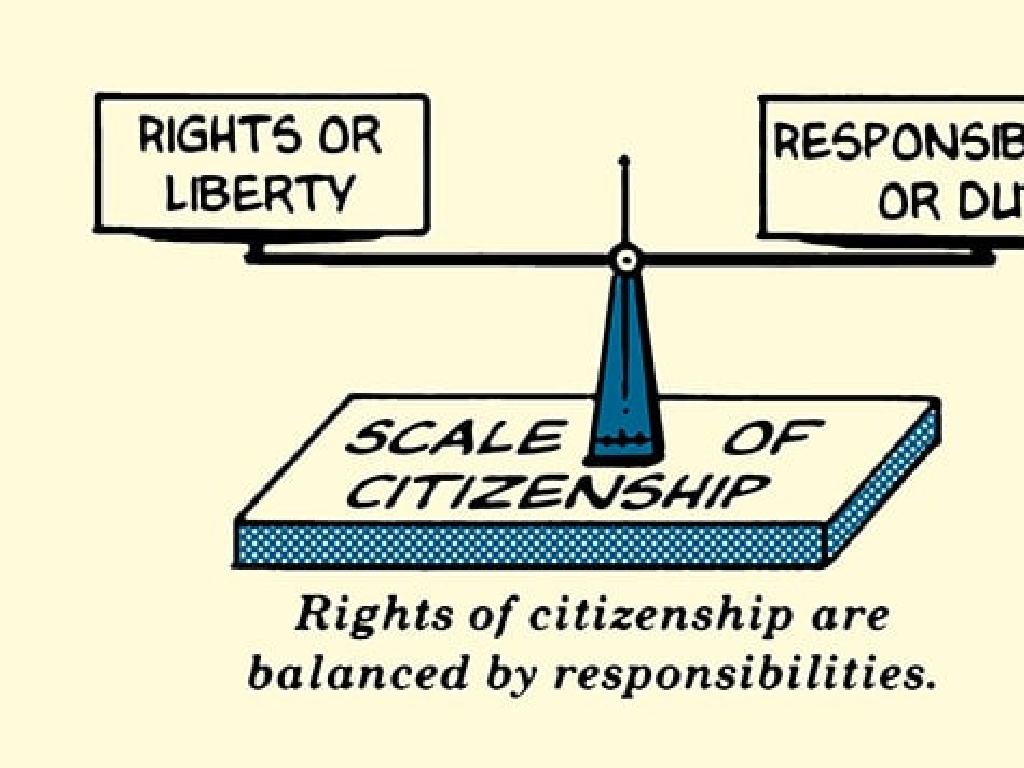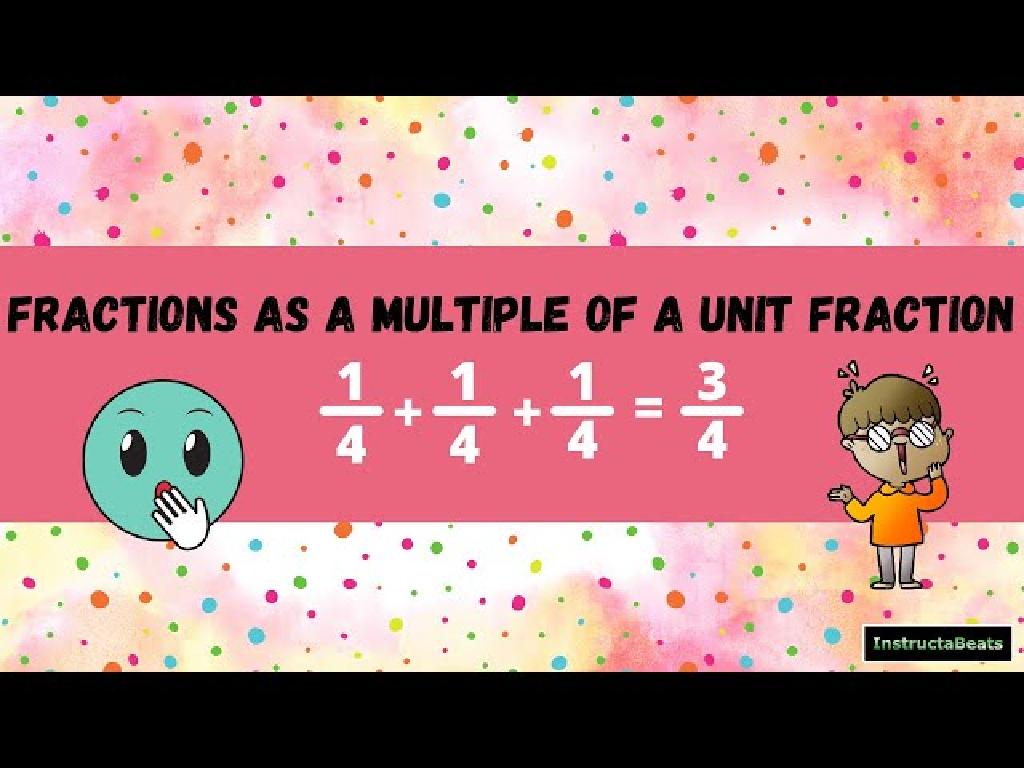Make Fourths
Subject: Math
Grade: Second grade
Topic: Fractions
Please LOG IN to download the presentation. Access is available to registered users only.
View More Content
Today’s Adventure: Making Fourths!
– Understanding parts of a whole
– A whole is like a pizza, cut into pieces
– What are fractions?
– Fractions show how many parts of a whole we have
– Fourths as equal parts
– Fourths mean a whole is cut into 4 equal pieces
– Visualizing four equal parts
– Draw a circle and divide it into 4 equal slices
|
This slide introduces the concept of fractions, focusing on ‘fourths’ as a part of the whole. Begin by explaining that a whole can be anything that is complete, like a pizza or an apple, and we can divide it into parts. Then, define fractions as a way to show how many parts of a whole we have. Emphasize that ‘fourths’ means we divide something into four equal parts. Use visual aids like drawing a circle (representing a pizza or a pie) and dividing it into four equal slices to help students visualize the concept. Encourage students to think of other items that can be divided into fourths and to practice drawing or cutting out shapes into four equal parts.
Understanding Fractions: Making Fourths
– A fraction shows part of a whole
– Top number is the numerator
– The numerator tells us how many parts we have
– Bottom number is the denominator
– The denominator tells us into how many parts the whole is divided
– Denominator shows equal parts
– For fourths, the denominator is 4 because the whole is divided into 4 equal parts
|
This slide introduces the concept of fractions to second-grade students, focusing on ‘fourths’ as an example. A fraction is explained as a way to represent a part of a whole, with the numerator indicating the number of parts taken and the denominator showing into how many equal parts the whole is divided. Emphasize that for making fourths, the denominator will always be 4, as we are dividing the whole into four equal parts. Use visual aids like pie charts or square blocks divided into four parts to help students visualize the concept. Encourage students to think of examples of dividing objects into four equal parts, such as cutting a pizza or a sandwich.
Let’s Make Fourths!
– Fourths: Dividing into 4 equal parts
– Each part is one fourth (1/4)
– Like cutting a pizza into 4 equal slices
– Four fourths make a whole (4/4)
– When you put all 4 slices back, you get the full pizza
– Visualizing and creating fourths
– Use paper folding or drawing to make fourths
|
This slide introduces the concept of ‘fourths’ to second graders, which is a fundamental aspect of understanding fractions. Start by explaining that dividing something into four equal parts means making ‘fourths.’ Use tangible examples like cutting a pizza or a sandwich into four pieces. Each piece represents one fourth (1/4) of the whole item. When all four parts are combined, they make up the whole (4/4), which is the same as the original item before it was divided. Encourage hands-on activities such as folding paper into four equal parts or drawing shapes divided into fourths to help students visualize and comprehend the concept. This interactive approach will aid in solidifying their understanding of fractions as parts of a whole.
Understanding Fourths
– A pizza divided into 4 slices
– Each slice is one fourth (1/4) of the pizza
– Chocolate bar in 4 equal parts
– Each piece is one fourth (1/4) of the chocolate
– Fold paper to show 4 parts
– Paper folded twice to make 4 equal sections
– Fourths in everyday items
– Look for items at home that are in four parts
|
This slide aims to help students visualize the concept of ‘fourths’ using familiar items. By seeing a pizza cut into four equal slices, they can understand that each slice represents one fourth of the whole pizza. Similarly, a chocolate bar can be broken into four pieces, with each piece being a fourth. Folding a square paper into four equal parts gives a hands-on experience of dividing an item into fourths. Encourage students to find and bring examples of items divided into four parts from their home, enhancing their understanding of fractions in a practical context.
Fun with Fourths!
– Fold paper into four equal parts
– Color one part to show one fourth
– Use different colors for each part
– Understand four fourths make a whole
– If you color all four parts, that’s a whole
– Share your colored fourths with the class
|
This activity is designed to help second graders understand the concept of fourths by visual and hands-on learning. Provide each student with a square piece of paper and guide them to fold it in half, and then in half again, to create four equal sections. Ask them to color in just one of the four parts to represent one fourth. Discuss how it takes four of these ‘fourths’ to make up the whole paper. Encourage them to color each fourth in different colors and then unfold the paper to see the whole as composed of four equal parts. This will visually reinforce the concept that four fourths make up a whole. Have the students share their work with classmates to build communication skills and solidify their understanding of fractions.
Class Activity: Fraction Art
– Divide paper into 4 equal parts
– Color each part a different color
– Share your art with the class
– Explain the four equal parts
– Each part is one fourth or 1/4 of the whole
|
This activity is designed to help students visually understand the concept of fourths. Provide each student with a piece of paper and coloring materials. Guide them to fold the paper in half twice to create four equal sections. Then, instruct them to color each section a different color. Once completed, have each student present their artwork to the class, explaining how they divided the paper and how each section represents one fourth. This hands-on activity reinforces the idea that a whole can be divided into equal parts, which is a fundamental concept in understanding fractions.
Review: Understanding Fourths
– Recap: What are fourths?
– Show one fourth of an item
Choose any classroom object, divide by 4.
– Ask questions about fourths
It’s okay to be curious, ask anything!
– Class participation encouraged
|
This slide aims to consolidate the students’ knowledge of dividing objects into four equal parts, or ‘fourths.’ Start by asking the class to summarize what they’ve learned about fourths to reinforce their understanding. Then, engage the students by having them visually demonstrate one fourth using classroom items, such as cutting an apple into four equal pieces or folding a paper into four equal sections. Encourage students to ask questions they may have about the concept of fourths to clarify any confusion and to ensure they are comfortable with the idea. The teacher should be prepared to answer questions and provide additional examples if needed. This interactive review session will help solidify the day’s lesson and assess student comprehension.
Conclusion: Understanding Fourths
– Excellent work on fourths today!
– Homework: Find and draw 3 items
– Look for items like a pizza or a paper
– Divide each item into 4 equal parts
– Make sure each part is the same size
– Share your drawings next class
|
Students have done a great job learning about dividing objects into fourths. For homework, they should find three items around their home that they can visually divide into four equal parts. Encourage them to think creatively and choose items of different shapes and sizes. They should draw these items and show how they would divide each into fourths, ensuring each part is equal. This exercise will help reinforce their understanding of fractions in a practical way. In the next class, students will have the opportunity to present their drawings and discuss the process of dividing each item into fourths, which will further solidify their grasp of the concept.






